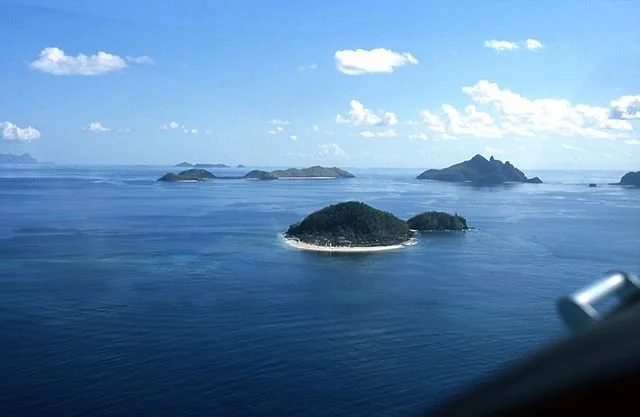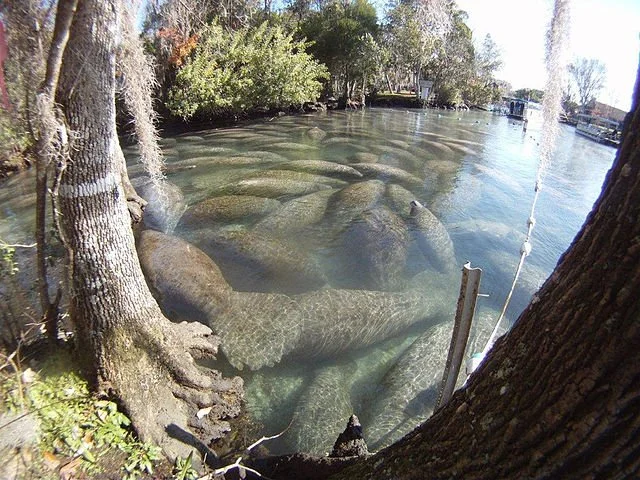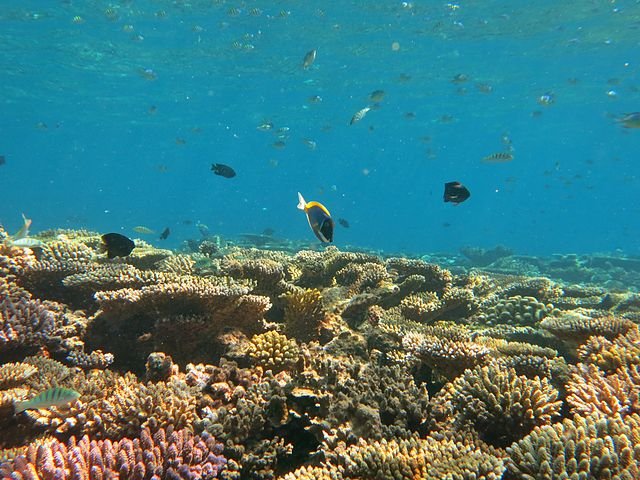There are a million places to get a taste of the most beautiful underwater ecosystems on Earth—here are some of the most fascinating.
One of the best ways to see the sea. John Brooks. CC 0
There are few environments more captivating than the ocean. Featuring millions of species of life, hundreds of different biomes, and almost infinite ways to experience it, there’s nothing quite like the sea. With a mask, fins and little to no training, snorkeling is the perfect way to see it all.
Of all of the places to snorkel, some are simply unlike any other. This list documents seven of the most mind-blowing experiences you could have underwater and why you should definitely add them to your bucket list.
1. Jellyfish Lake, Palau
The 250-island nation of Palau is dotted with saltwater lakes linked together by a series of underground channels and tunnels. Only one of these lakes can be visited, fittingly named Jellyfish Lake, home to a dizzying number of moon and golden jellyfish. They float around aimlessly in the 1,500-foot lake, bumping and bouncing up against snorkelers like living ping-pong balls. These creatures have evolved in a much different way from their ocean-dwelling cousins— they pose no risk to snorkelers. Unlike most species, they are non-poisonous and have no stinging cells.
Jellyfish Lake provides visitors with the once-in-a-lifetime experience of swimming through an entire world of these unique and fascinating creatures. It is more than worthy of a spot on every ocean lover’s bucket list. Places to stay nearby include the Palau Pacific Resort, priced at around $250 a night. Cheaper options include the Hotel Piccada at $110 a night and LH Porto Rafael Altura Resort at $80 a night.
A diver in Jellyfish Lake in Palau. Aquaimages. CC SA 2.5
2. Silfra Fissure, Iceland
Created by an earthquake in 1789, the Silfra Fissure is a massive gap between the North American and Eurasian continental plates filled with glacier meltwater. Snorkelers and divers can simultaneously touch two continents while swimming through gorgeously clear waters, where visibility can reach a mindblowing 393 feet.
This unique ravine is almost totally devoid of fish. Instead, the rock walls are lined with vibrant green algae known as “troll hair.” Between these leafy green plants and the almost impossibly clear blue water, Silfra Fissure is one of the most incredibly colorful and exotic dive sites on Earth. Silfra Fissure’s water is extremely cold, sitting at a chilling 35-39 degrees Fahrenheit. To combat this temperature, snorkelers wear a drysuit, a full-body neoprene suit complete with gloves, boots and a hood.
Nearby places to stay include the Bru Country Estate at around $110 a night, as well as several rentable cottages at around $90 per night.
An underwater view at the Silfra Fissure. Josephyoon4. CC BY-SA 4.0
3. Mamanuca Islands, Fiji
Called the soft coral capital of the world, Fiji is an absolutely beautiful diving location. Its Mamanuca Islands are home to almost 400 unique species of coral, most of which are still alive despite the ravages of ocean acidification. Many of the islands themselves are also covered up by water when the tide comes in, combining the surface world and the sea in an incredible panorama. Snorkelers can visit these gorgeous reefs from any of the 13 inhabited islands, each lined with fantastic beaches and surrounded by crystal-clear water.
The island’s amount of healthy and colorful coral can’t be found anywhere else in the world. As climate change worsens, there’s no guarantee it’ll be around forever. Mamanuca is definitely one for the bucket list. Local hotels include First Landing Beach Resort at around $119 a night and Bluewater Lodge at around $60 a night.
An aerial view of the Mamanuca Islands. American. CC BY-SA 3.0
4. Whitsunday Islands, Australia
The Whitsundays, as they are locally known, are a series of 74 islands off the coast of Queensland, Australia. The most fascinating part of snorkeling in the Whitsunday Islands snorkeling is the Stepping Stones, a unique series of flat rock cylinders jutting up from almost 80 feet underwater. Swarming with batfish, wrasses and a wide variety of eels, these rocky structures are absolutely covered in coral.
The Stepping Stones are unlike anything else in the world. Of all the beautiful diving locations on the colossal Great Barrier Reef, there are few quite as unique as this. Local hotels include the Mantra Club Croc at $106 a night and the Kipara Tropical Rainforest Retreat at around $105 a night.
The Whitsunday Islands. eyeintim. CC 2.0
5. Isla Mujeres, Mexico
The biggest shark on Earth and completely harmless to humans, the whale shark swims docilely around feeding on tiny animals filtered through their colossal mouths. There are very few places on Earth where one can swim with these gentle giants, and Isla Mujeres is the best place to do so. Tours of the island are regulated by the government, allowing only a limited number of snorkelers in the water in order to avoid disturbing the creatures.
Isla Mujeres also features the world’s largest underwater museum, with more than 500 sculptures scattered across the ocean floor . From spectral human figures to huge stone grenades and mines, the legendary MUSA Museum provides snorkelers with a once-in-a-lifetime experience that has not been replicated anywhere else on Earth.
Whale sharks are incredible creatures, and Isla Mujeres offers one of the only ways to see them in their natural habitat. Hotels in the area include Hotel La Joya Isla Mujeres at $99 a night and the Ixchel Beach Hotel at around $165 a night.
A whale shark off the coast of Isla Mujeres. MarAlliance2018. CC BY-SA 4.0
6. Crystal River, Florida
Offering another first-hand experience with marine life, the Crystal River in Florida is the only place in the U.S. where snorkelers can come face-to-face with the endangered manatee. Lucky visitors can swim through hundreds of the bulky mammals as they make their way towards warmer waters for the winter. Many of the animals even choose to remain in parts of the river year-round.
Manatees are one of the most protected aquatic species in the world given how endangered they have become. Tours must be booked in advance through organizations that hold special permits, and snorkelers are strictly forbidden from touching the manatees. However, these animals are as curious as they are goofy— there is every chance that they’ll wind up bumping into you themselves.
There aren’t many manatees left on Earth. Crystal River does its utmost to protect the population that returns to its warm springs every year, and is gracious enough to provide visitors with the chance to meet these amazing creatures. This is a can’t-miss experience for anyone who loves the sea. Local hotels include the Plantation Resort on Crystal River from $113 a night and the Port Hotel and Marina at $105 a night.
A herd of manatees in Crystal River. U.S. Fish and Wildlife Service Headquarters. CC 2.0
7. Baa Atoll, Maldives
Dubbed a UNESCO World Biosphere Reserve, Baa Atoll is a nearly perfectly preserved reef. Famed for its unbelievably rich ecosystem, the atoll is home to manta rays, whale sharks and several other endangered species which remain safe and secure in this heavily protected environment.
Coral reefs—and the animals that make their homes there—have been hit hard by climate change. Fortunately, humanity has stepped up to protect what we still can. Baa Atoll is a spectacular example of how we can still save our world and is well worth a visit to inspire others to help where they can as well. Local hotels are around $200/night and up.
The spectacular reefs of Baa Atoll. Ahmed Abdul Rahman. CC BY-SA 4.0
Largely still unexplored, the ocean is an entirely different world from the one we live in. The sheer amount of environments, animals and experiences that can be found are unparalleled in variety and beauty. Thanks to snorkeling, you can see some of the most gorgeous sights on Earth up close. In a world that’s constantly turning up new and unbelievable discoveries, there’s no telling what you’ll find on any given snorkeling session, no matter where you are.
Ryan Livingston
Ryan is a senior at The College of New Jersey, majoring in English and minoring in marketing. Since a young age, Ryan has been passionate about human rights and environmental action and uses his writing to educate wherever he can. He hopes to pursue a career in professional writing and spread his message even further.









